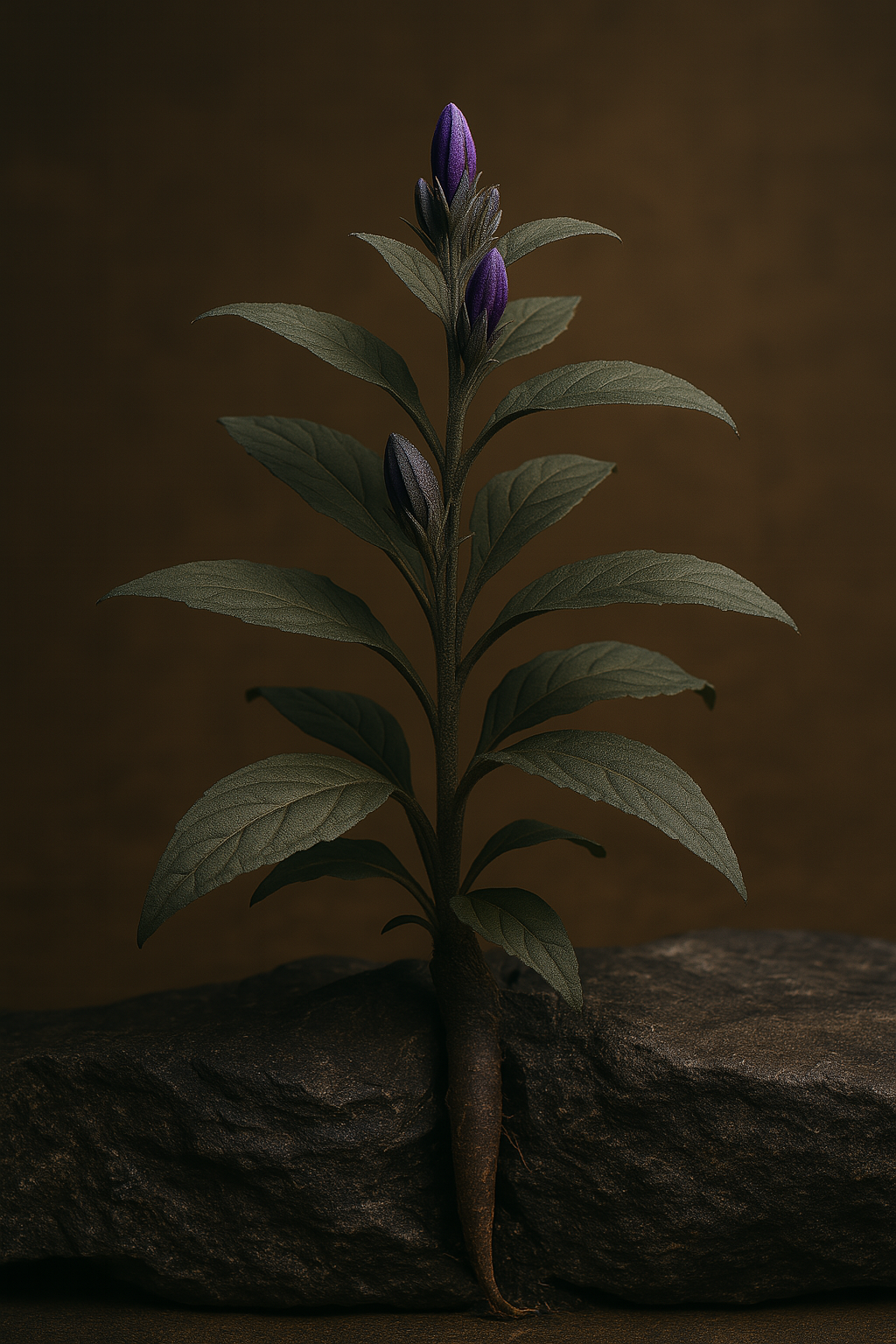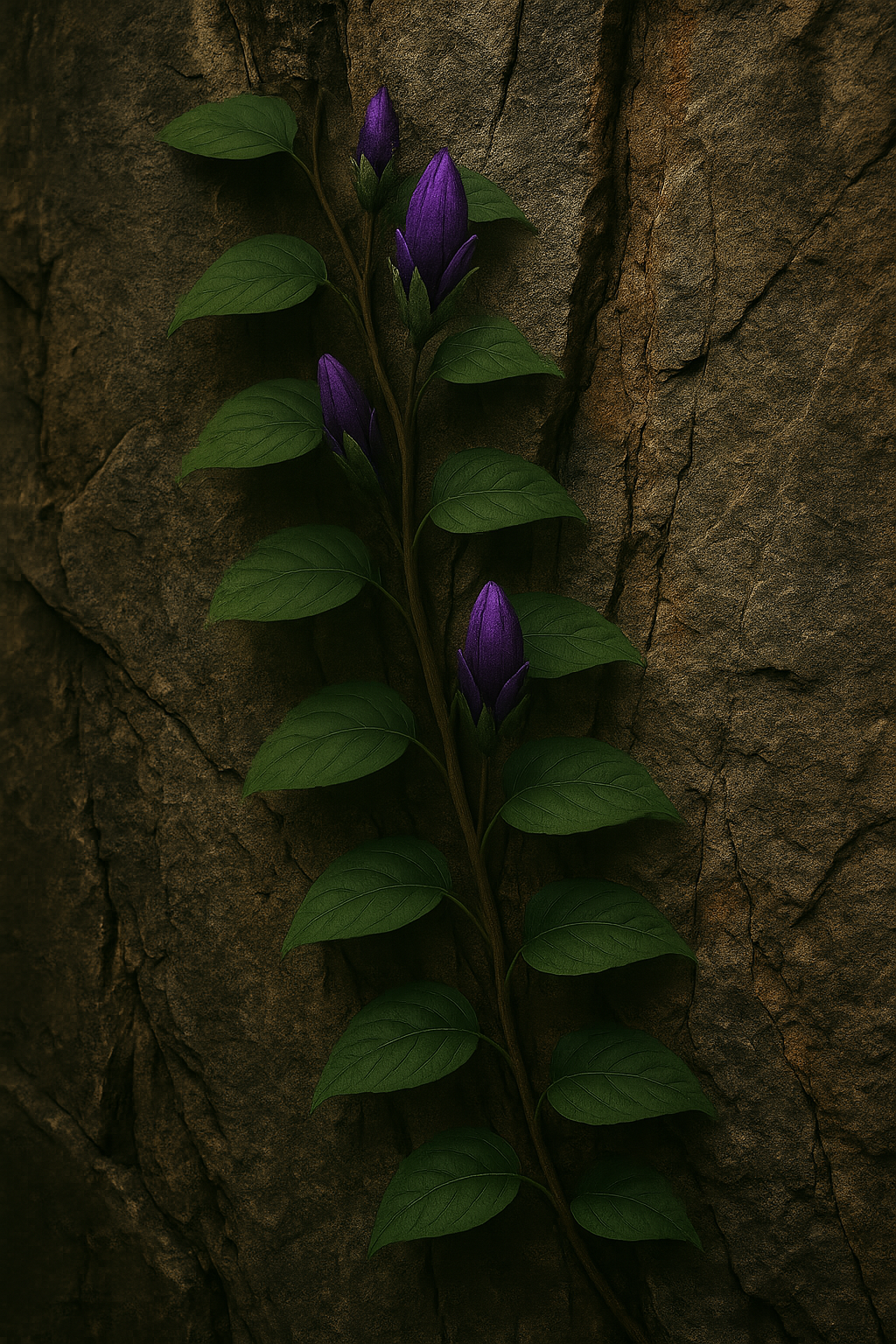Blackjaw Plant
Scientific Name: Gnathora obsidianis
Common Names: Blackjaw, Ashroot, Bittermaw, Grinder’s Root, Nightgnaw
Family: Solancharaceae (Nightvein family)
Type: Rare root-bearing narcotic plant
Native Region: Firepeak Divide
Description
Blackjaw is a low, thorny vine with wide, dark green to purple, waxy leaves and veined stems that appear scorched. It does not flower and propagates through root runners. Its prized feature is its taproot—thick, gnarled, and pitch black. When split, it releases a sharp metallic scent and seeps a dark resin-like sap. The taproot's chemical profile includes volatile alkaloids that act as a psychoactive stimulant—but only if harvested under precise environmental conditions. Critical Harvest Requirement
Common Names: Blackjaw, Ashroot, Bittermaw, Grinder’s Root, Nightgnaw
Family: Solancharaceae (Nightvein family)
Type: Rare root-bearing narcotic plant
Native Region: Firepeak Divide
Description
Blackjaw is a low, thorny vine with wide, dark green to purple, waxy leaves and veined stems that appear scorched. It does not flower and propagates through root runners. Its prized feature is its taproot—thick, gnarled, and pitch black. When split, it releases a sharp metallic scent and seeps a dark resin-like sap. The taproot's chemical profile includes volatile alkaloids that act as a psychoactive stimulant—but only if harvested under precise environmental conditions. Critical Harvest Requirement
“The root is nothing but ash and bitterness unless you pluck it when the world still sleeps and frost kisses the earth.” —✎ Eldrin Sarvo, herbalist of the Lankhmarian Apothecarion GuildThe narcotic potency of the Blackjaw Root hinges entirely on temperature at the moment of harvest. To trigger its psychoactive properties, the root must be unearthed when the soil at root depth lies precisely between 35°F and 45°F (1.6°C to 7.2°C)—a narrow and fleeting thermal window that most often occurs just before sunrise in the cold months or under heavy cloud cover. This phenomenon is not arcane, but alchemical: the root contains volatile alkaloids that crystallize into their narcotic-active form—commonly known as "black resin"—only when exposed to sustained cold. These alkaloids are thermo-reactive, requiring molecular tension induced by chill conditions to bond correctly and create the psychoactive compound. Without this transformation, the root remains chemically dormant. If the root is pulled from the earth outside this precise temperature window, it is still edible, extremely bitter, but entirely non-narcotic. Such roots offer no euphoria, no visions, and no clarity—just the lingering taste of scorched metal and disappointment. Why So Cold? Scholars speculate that Blackjaw evolved this chemical mechanism as a form of environmental trigger, reacting only when day-night temperature swings in the volcanic uplands reach extreme lows. This ensures the plant’s psychoactive properties are guarded and rare—emerging only when specific natural rhythms align. Some believe the plant wants to be harvested only by those wise or desperate enough to understand its pattern. Artificial Simulation While a few bold alchemists have attempted to reproduce this thermal state using spells like Control Temperature, Cone of Cold, or magically chilled harvest chambers, purists and mystics alike claim the true effect only emerges in natural frost. They refer to it as “the breath of the dark earth,” claiming that even magically cooled roots lack the dreamlike lucidity and prolonged clarity that naturally harvested resin provides. Habitat & Distribution The Blackjaw Plant is found exclusively in the Firepeak Divide, a scorched volcanic plateau rising to 9,900 feet within the treacherous folds of the Trollstep Mountains. This region, shaped by ancient lava flows and littered with steaming geothermal vents, is both geologically volatile and ecologically unique. High winds, sudden tremors, and rivers of cooling obsidian make it perilous to navigate—and nearly impossible to cultivate outside its native soil. The plant thrives in ash-rich, porous volcanic substrate, often in the shadow of jagged basalt shelves or tucked into fissures warmed by the earth’s breath. Its roots anchor deep into mineral-heavy ground where the balance between geothermal heat and cold mountain air creates a fragile, seasonal equilibrium—conditions essential for the development of its psychoactive compounds. The surrounding settlements of Mlurg Nar and Cold Corner have long spoken of the plant in tones of fear, reverence, or superstition. Local guides occasionally lead daring alchemists, smugglers, or vision-seekers into the Divide in search of the Blackjaw Plant, but few return unscathed—and fewer still with a viable, narcotic-active specimen. No known efforts to transplant or cultivate Blackjaw outside of the Firepeak Divide have succeeded. The plant withers and dies even under magical conditions, leading scholars to conclude that its potency is inextricably tied to the plateau’s volatile, living terrain. Uses and Effects Leaves: Dried and brewed as tea. Bitter, mildly energizing, improves alertness and suppresses appetite. Widely used by sentries, caravan guards, and late-night scholars. Root: When harvested properly and processed—usually by drying, curing in ash, or infusing with alcohol—the root becomes a powerful narcotic and stimulant. Effects include:
- Euphoric detachment
- Heightened sensory perception
- Mild time distortion
- Temporary clarity or insight (claimed by arcane users)
“My nan said the Ash-Mother walks the Divide at dusk. You’ll feel her behind you, whisperin’ in your ear before you dig. If you pull the root anyway, well... she’ll follow you home.” — Brylla Crake, seamstress of Mlurg NarAmong the people of Mlurg Nar, stories of the Ash-Mother have been passed down for generations. Said to be a sorrowful spirit born of molten stone and grief, she is believed to guard the Firepeak Divide from greed and desecration. Those who dare to harvest Blackjaw without humility or ritual are said to feel her presence at their back—silent, watching. If ignored, she doesn’t stop you... but she does follow. Some who return from the Divide speak of dreams thick with smoke and a cold hand pressing on their chest at night. The Cursed Breath of the Mountain
“Blackjaw didn’t grow from soil—it grew from fury. The fire god that sleeps beneath the Divide coughed it up when men broke his stones. Every time you chew that root, you wake a little more of his rage.” — Old Samket, Cold Corner hunter and lay priestA common belief in Cold Corner holds that a forgotten fire deity slumbers beneath the Divide. According to this legend, when greedy miners and alchemists desecrated sacred ground long ago, the mountain itself shuddered in anger, and from its cracked surface emerged the Blackjaw Plant—its bitterness a curse, its visions a warning. Each use of the plant is thought to stir the god’s rage anew, bringing the day closer when he will awaken and cleanse the land in flame. Jaw-Taker’s Bargain
“You ever see a Blackjaw addict smile? Didn’t think so. That’s ‘cause the Jaw-Taker comes for your teeth. Every vision’s a bargain—you chew the root, he chews your bones.” — Tirren Vox, caravan surgeon, trader of odditiesA widespread superstition among traveling traders and mountain folk speaks of the Jaw-Taker, a vengeful spirit or ancient entity who enforces the “unspoken price” of Blackjaw’s gifts. The tale goes that every hallucinogenic vision granted by the root costs the user a piece of themselves—starting with their teeth. Addicts often wake with aching jaws, clenched muscles, or bleeding gums. Some say this is due to the plant’s toxicity. Others whisper it's because the Jaw-Taker came in the night, silently collecting his due. The Vine That Watches
“The old ones say it sees you. The vine, I mean. When you go to pull it, it tenses. And if it don’t want to be taken, it hums. Not loud—just enough to crawl into your spine. That’s why I harvest blindfolded.” — Druvek the Quiet, outlaw herbalist of the Trollstep rimA newer myth gaining traction among Blackjaw harvesters suggests that the plant itself is aware—or at least, possessed of a kind of slow, plant-born sentience. According to some, the vine seems to twitch when disturbed, and harvesters report feeling watched, even in solitude. More chilling still are stories of an almost imperceptible hum rising from the soil just before the root is exposed—a sound described not with the ears, but with the bones. Whether this is real or the delusion of those too deep in their cups (or their own product) remains uncertain. But among experienced gatherers, one phrase is whispered with increasing seriousness: “The vine sees who takes it.”
Scientific Name
Gnathora obsidianis
Discovered by




Comments